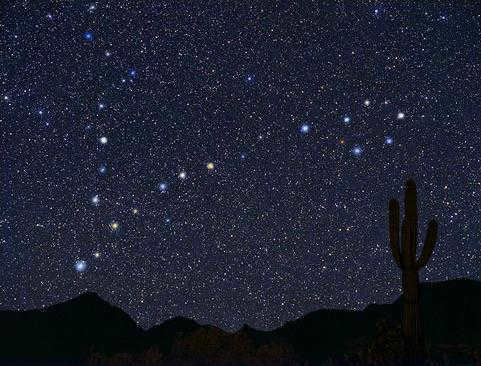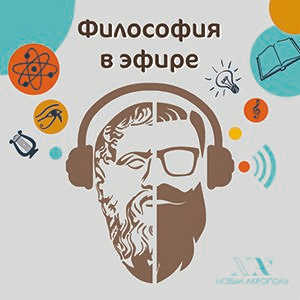Astronomers in the present day refer to constellations as designated areas in the sky that aid in navigation. In ancient times, groups of stars were identified as representations of people and animals, formed by the random alignment of the brightest stars. Typically, constellations are named after mythological characters, real-life heroes, animals, and even objects. Various cultures around the world created different figures using the same collection of stars, akin to a connect-the-dots game.
In the past, this practice of envisioning images in the stars helped people track the changing seasons. Due to the varying distances of the stars, constellations would appear entirely different to someone observing them from another planet.
Astrological Charts
An astrological chart, also known as a birth chart or horoscope, is a map of the positions of celestial bodies at the time of a person’s birth. It is used in astrology to interpret and analyze the individual’s personality traits, life events, and future prospects.
Astrologers divide the chart into twelve houses, each representing different aspects of life such as career, relationships, and health. The positions of the sun, moon, planets, and other celestial bodies within these houses provide valuable information for astrological readings.
Unlike star maps, which focus on the physical location of stars and constellations, astrological charts are more concerned with the symbolic meanings and influences of these celestial bodies. They are used to gain insight into a person’s character and destiny.
Astrological charts have been used for centuries by cultures around the world, and different traditions have developed their own unique methods and interpretations. Tools such as an ephemeris and an astrology software program can be used to generate accurate and detailed charts.
Locating constellations visibly
Utilizing a star chart would be the most helpful resource in locating a constellation, based on the specific location and time of year. The optimal conditions for observation will vary depending on your geographical area and the time of year. Therefore, utilizing a tool such as AstroViewer will be beneficial. This tool allows you to input your location and provides you with a personalized star map. Another excellent option is the Starmap app, which is compatible with iOS devices. You can download these resources in PDF format, print them, and bring them along with you. Google Sky is also a useful tool for practicing the identification of constellation shapes.
In addition to having a star chart, it is important to have access to a dark sky, ideally far away from urban areas. It can also be helpful to have additional visual aids such as binoculars or a telescope. While it is possible to see the basic outlines of a constellation with the naked eye, using a specialized device allows you to observe fainter stars and other celestial objects like nebulae and star clusters. Below, you will find the “most viewed” month for each constellation. While many constellations are visible for at least 6 months of the year, they may not appear as bright during every month.
The motion of celestial bodies among the constellations
Stars are in constant motion due to the rotation of the Earth. The Earth’s rotation occurs from west to east, causing the stars to appear to rise in the east, pass through the southern part of the sky, and eventually set in the west. Occasionally, the Sun can also be observed moving through the constellations, completing a full circle in 365 days.
The Earth has a tilt of 23.5 degrees from the vertical axis, resulting in the creation of seasons and a shift in our perception of the sky. This phenomenon explains why we observe different constellations in each season. However, there are certain constellations that remain visible throughout the year. These constellations are known as circumpolar constellations, as they appear to encircle the North Star, Polaris. Due to our location in the Northern Hemisphere, we have the privilege of observing these constellations all year long. The circumpolar constellations include the Big Dipper, Cassiopeia, the Little Dipper, and the Swan.
The constellations of the zodiac are the constellations that are situated along the plane of the ecliptic. The ecliptic represents the visible path of the Sun as it moves across the sky. In simpler terms, the Sun passes through these constellations throughout the year. This cycle of the Sun’s passage through the zodiac was utilized by ancient civilizations to determine the time of year.
Most of the planets in our solar system have orbits that align closely with the plane of the ecliptic, typically within a range of about 8 degrees above or below it. In modern times, the term zodiac is primarily associated with astrology, where the 12 signs of the Western zodiac correspond to the 12 constellations that are observed along the ecliptic. The cardinal signs, namely Aries, Cancer, Libra, and Capricorn, signify the start of the four seasons, indicating that the Sun is believed to enter these signs on the first days of spring, summer, fall, and winter, respectively.
Best 8 constellations
Constellations are a remarkably stunning and extraordinary phenomenon. Our predecessors, living in an era devoid of technology, were mesmerized by the remarkable gatherings of stars in the celestial sphere. Scientists have identified numerous constellations for various reasons, yet only a handful of them possess true beauty and enigma. In this piece, we will acquaint you with the constellations that hold the highest recognition and are most easily observable to the unaided eye in the Northern Hemisphere.
Orion
Tonight, you have the opportunity to observe Orion, also known as the Hunter. This constellation is easily recognizable and can be seen rising in the middle of the evening.
As December approaches, people begin to notice Orion in the evening sky and engage in discussions about it. Typically, the constellation rises above the eastern horizon at around 9 PM and can be observed for several months.
One of the most prominent features of Orion is a chain of stars known as Orion’s Belt. This chain consists of three medium-bright stars arranged in a short straight row. From mid-northern latitudes, it appears as though Orion is lying on its side, with the belt stars pointing upwards.
When Orion first rises early in the season, two bright stars, Betelgeuse and Rigel, shine on opposite sides of the Belt.
The Little Bear Constellation
The Little Bear constellation can be observed throughout the year in the northern hemisphere. It is classified as a circumpolar constellation, which means that it remains visible all night long. This small constellation covers an area of 256 square degrees and holds the 56th position among the 88 constellations in the night sky.
One of the distinctive features of the Little Bear constellation is the presence of the Polaris star, situated at the end of the dipper’s handle. Polaris earned its name due to its proximity to the north celestial pole. As a result, when the Earth rotates, Polaris remains fixed in the sky while the other stars appear to revolve around it.
Due to the Earth’s axial wobble, Polaris will not always remain as Polaris. In approximately 14,000 years, Vega will take over as the north celestial pole. This phenomenon, wherein the positions of stars change, is referred to as procession. Polaris holds significant significance in navigation, aiding sailors in accurately determining their whereabouts.
The Lesser Bear is a constellation that was identified by the Greek astronomer Ptolemy in the 2nd century. It is called “Ursa Minor” in Latin. This constellation has been of great importance to various cultures throughout history. The ancient Babylonians referred to it as the celestial chariot. In Greek mythology, the constellation is linked to two different stories. One tells the tale of Ida and her sister Adrasteia, nymphs who took care of Zeus on the island of Crete. They were rewarded by being placed in the heavens. Another story involves Arcas, the son of Zeus and the nymph Callisto. Arcas and his mother were transformed into bears and immortalized in the night sky.
The constellation known as the Big Dipper is the most well-known formation of stars in the night sky. In Russia, it is recognized as the figure of a dipper. Legend has it that the Big Dipper was once a beautiful maiden named Callisto, who was involved in a romantic affair with the god Zeus. In order to protect Callisto and their son Arcas from Zeus’s jealous wife Hera, Zeus transformed them into bears. He then lifted the bears by their short tails and threw them into the sky, causing their tails to stretch out. As mentioned earlier, Arcas can be seen in the night sky as the constellation of the Little Bear.
The Big Dipper constellation can be seen year-round by observers in the Northern Hemisphere. It never dips below the horizon, although it appears lower in the winter months. On a clear night, the Big Dipper is easily recognizable in the northern sky.
Aries
Aries, also known as the ram, is the initial of the 12 constellations of the zodiac and symbolizes the start of spring, known as the vernal equinox. The point at which the Sun crosses the celestial equator is referred to as the first point of Aries. This location was established in ancient times. However, due to the Earth’s orbit wobbling, known as precession, this point has now shifted to the western region of Pisces.
Similar to all other zodiacal constellations, Aries can only be observed in the sky during opposite times of the year, specifically during the autumn season.
The identification of this group of stars can be traced back to the era of the ancient Greeks and Romans. It represents the Golden Ram, which was offered as a sacrifice by Phrixus to bring fertility to his homeland in Thessaly. The Golden Fleece of the sacrificial ram was entrusted to Jason and the Argonauts for their return journey. Aries does not contain many notable celestial objects and only has a handful of stars that are of interest. Notably, there is a triangle formed by the prominent stars in the constellation. Due to the path of the ecliptic, planets are often visible in this part of the sky.
Taurus
Taurus is a zodiac constellation that becomes visible in the night sky during the winter and spring seasons in the northern hemisphere (or during summer and fall in the southern hemisphere). The period between May 14 and June 21 marks the sun’s passage through the Taurus constellation, although it is not visible during this time due to the sun’s presence within its boundaries. For a better chance of spotting Taurus, try observing the constellation in the early evening sky during the opposite time of the year.
To locate Taurus, begin by observing the trajectory of the sun. It is important to keep in mind that zodiacal constellations consist of groups of stars that mark the sun’s yearly path across our sky. This is why they held such significance and intrigue for early astronomers. The provided information will assist you in locating these constellations in the nighttime sky. Once you have attuned yourself to the sun’s path, allow the three renowned stars of the Orion constellation belt, known as the Hunter, to guide your gaze. Orion and Taurus are the nearest neighbors in the celestial sphere.
Experienced stargazers often rely on Orion’s Belt to locate Taurus’ most prominent markers: the V-shaped Hyades star cluster featuring the brilliant star Aldebaran at its center, as well as the breathtaking Pleiades star cluster.
Gemini is a constellation located in the northern sky and is considered one of the zodiacal constellations. These constellations are the areas of the sky that encompass the visible paths of celestial bodies such as the sun, moon, and planets. Gemini has been documented by various cultures throughout history and is currently recognized as one of the 88 official constellations designated by the International Astronomical Union (IAU).
In Egyptian astrology, the constellation was believed to represent two goats, while in Arabic astrology, they were seen as the peacock twins. The Western world commonly associates these twins with Castor and Pollux from Greek mythology. However, other sets of twins associated with the Twins in Western culture include the elder and younger Horus and the legendary founders of Rome, Romulus and Remus. Gemini also served as the inspiration for the Gemini program, a NASA space mission in the 1960s that sent pairs of astronauts into space aboard the Gemini spacecraft. This constellation has also influenced the names of various astronomical facilities, such as the Gemini Observatory (which consists of two 8.1-meter optical/infrared telescopes located in Hawaii and Chile) and the Gemini Planet Imager utilized by the Gemini South telescope in Chile.
Virgo
The constellation Virgo occupies an area of 1,294 square degrees. While most of the stars in this constellation are not very bright, it is relatively easy to locate the bright blue-white star known as Spica.
To find Spica, one can use the Big Dipper as a guide. Simply follow the curved handle of the Big Dipper towards the southeast until you come across the prominent star called Arcturus, which is part of the constellation Boötes. From there, continue along the same arc to reach Spica. A helpful mnemonic phrase to remember this is “Follow the arc to Arcturus and then to Spica.” Known for its associations with fertility and agriculture, the Virgo constellation is visible in the spring and summer months in the Northern Hemisphere, and in the fall and winter months in the Southern Hemisphere.
Libra
The cluster of stars known as Libra has a fascinating history.
Due to the faintness of the stars in this constellation, it was challenging for ancient observers to confirm its existence. The Babylonians identified the scales and associated them with the judgment of both the living and the dead. The ancient Greeks saw the extended “claws” of Scorpio instead. However, it was during the Golden Age that Rome embraced Libra as a symbol of divine justice, harmony, and equilibrium.
There is a vast number of constellations, but astrologers consider these to be the most fascinating and extraordinary.
Fortune-telling through constellations
Constellations are occasionally utilized for divination purposes. It is common knowledge that all celestial objects, including our planet Earth, are in perpetual motion. This implies that the positions of the stars are constantly changing.
Many astrologers believe that by observing the shifts in the stars and constellations, it is possible to make predictions about the future. They base this assumption on the alterations in the background of electromagnetic fields, which to some extent influence human activity.
If we consider the role of constellations not from a scientific perspective, but from a layman’s point of view, we can observe that ancient civilizations also relied on constellations for similar purposes. They predicted natural disasters, abundant harvests, and even weddings.
Summarizing
After reading the article, you have gained knowledge about constellations and how to navigate using the stars. You have also discovered that finding just one star can lead you to a whole constellation. The article also provided information about the location, size, and myths surrounding famous star clusters. Additionally, observing constellations can be a fun activity for a romantic date, and astrologers often use stars for their predictions.
While many are familiar with Zoroastrian (Persian), O Vedic (Indian), and Western astrology, few know that the Slavs and Aryans had an extensive system of astrology and cosmology. Our ancestors had a deeper understanding of cosmology than modern scientists and knew how to apply this knowledge in practical ways.
Before we delve into a detailed discussion of Slavic astrology, it is important to establish some terms and concepts.
Slavic Notions of Stars and Earths
Svarozhiy Krug – refers to the Milky Way, where the Yarilo Sun travels, passing through the 16 Heavenly Towers.
CHERTOGUE is a region of the universe where Suns, Stars, and Star clusters gather.
STARS are celestial bodies that emit light, and they have systems with up to 7 Earths (planets) orbiting around them. These Earths, in turn, have celestial Objects (moons, satellites) revolving around them.
The SOLAR is the central luminous body around which more than 7 Earths orbit in their respective orbits.
EARTHS are celestial Objects that orbit stars (or suns).
MOONS are celestial objects that orbit around the Earths.
The name of our Sun (Star) is YARILO, and it is orbited by 27 Earths (leading to the expression – “for three nine Earths, to the three tenth Kingdom”, which refers to beyond the solar system).
The Yarila Sun system originally had 27 Earths (including the Earth of Dei, which is now destroyed and forms an asteroid belt in its orbit. This was referred to as “tridevyatel’nye zemli”).
Our Earth is known as Midgard-Earth in the Slavic-Aryan tradition. It is surrounded by three moons (referred to as the period of Three Moons in many cultures):
1. LELA – the nearest Moon, was destroyed by Dazhdjbog. It completes one orbit in 7 days, which is why many cultures have a 7-day week in their calendars.
2. FATTA – The period of circulation for FATTA is 13 days. The priests of Atlantis destroyed it, resulting in the emergence of the expression “fatality” and a negative connotation surrounding the number 13.
3. MONTH – The duration of a MONTH is 29.5 days. We commonly refer to our Moon as MONTH as well. Life throughout the Universe adheres to consistent laws that remain unchanged (as above, so below), and the Gods Ramhat and Numerabog ensure the observance of these laws.
All planets emit energy as they rotate on their axis and revolve around Yarilo. Yarilo, in turn, orbits the Center of the galaxy. This forms a closed oscillating circuit where subtle forms of energy are radiated, ultimately nourishing the Sun. These energies flow both inward and outward, resulting in every celestial body being influenced by the Stars, Earth, and Sun.
About the star groupings
In 1922, the I General Assembly of the International Astronomical Union convened in Rome and officially approved a list of 88 constellations that divide the starry sky. Out of these 88 constellations, only 47 have been known for several millennia and are considered ancient. These constellations are based on the mythology of ancient Greece and cover the portion of the sky visible from southern Europe. The remaining constellations were introduced in the 17th and 18th centuries. During the primitive era, which spanned from 4 to 6 millennia BC, ancient scientists in Russia identified 27 constellations in the northern and southern regions. Additionally, there are 12 constellations known as the zodiacal constellations, which are the constellations through which the Sun passes (excluding the Serpent constellation). These zodiacal constellations correspond to the 12 tribal unions of the Valdai Upland.
In ancient eras, constellations served as meaningful clusters of stars that aided in navigation through space and time. However, these constellations were closely tied to specific historical events and their corresponding geographical coordinates from ancient history. The earliest identifiable groupings of prominent stars were identified by early humans during the Stone Age. Different civilizations and time periods utilized varying methods to divide and categorize the vast expanse of the night sky.
In the 4th century BC, China had a total of 122 constellations, which consisted of 809 stars. Around 275 BC, the Greek poet Aratus mentioned these constellations in his poem called “Apparitions”. However, Aratus actually used an earlier description of the celestial sphere in his poem. In Claudius Ptolemy’s book “Almagest” (137g), he described 48 constellations, mostly from the northern sky. Interestingly, 47 of these constellations still retain their original names, while one large constellation – Argo, which represents the ship of Jason and the Argonauts – was divided into four smaller constellations in the 18th century: Kiel, Korma, Sails, and Compass. The remaining changes to the constellations were made during the Middle Ages when star chart makers introduced new ones. In the 18th century, Mongolia had a list of 237 constellations. In Inca astronomy, the dark parts of the Milky Way were the main focus of observation. These dark areas were considered as “constellations in reverse” in the Andean cultures, and they included figures like Lama, Lama’s Child, Shepherd, Condor, Chicken, Toad, Snake, and Fox. Additionally, the Inca astronomers also studied stars such as the Southern Cross, Pleiades, Lyra, and others.
Regardless of our location on a clear night, we always perceive all celestial bodies as equidistant and arranged on the inner surface of a sphere. However, this perception of the celestial sphere is actually an illusion. For centuries, it was believed that the celestial sphere represented the boundary of the universe. But in 1837-1839, the measurement of annual parallaxes of certain stars revealed that they were actually located at significant distances from us, debunking the notion of the celestial sphere as a physical reality. Nonetheless, the concept of the celestial sphere continues to be utilized in the field of astronomy.
In reality, the celestial sphere provides us with projections of stars and other celestial bodies. While they may appear to be closely grouped together to us, they could actually be separated by vast distances in space.
The starry sky remains constant in appearance over time, as ancient astronomers first discovered. However, it is important to note that due to the Earth’s precession, the view of the starry sky does undergo gradual changes over a span of approximately 25,900 years. These changes are exceedingly slow, requiring thousands of years to become noticeable.
The initial astronomers observed that the same constellations would appear in the starry sky during every season – spring, summer, fall, and winter. As a result, they began to utilize these constellations as a means to measure time.
An Earth star chart
The division of zodiacal constellations and a majority of the constellations in the northern celestial hemisphere took place in Russia around 5500 B.C. The ancient Greeks acknowledged the Russian division of constellations, but assigned them new names. In the “Iliad,” Homer describes the constellations depicted on Achilles’ shield as the Big Dipper, Volopassus, Orion, Pleiades, and Hyades – the gods Hephaestus. These constellations serve as a map of northern Russia.
As per the decision of the International Astronomical Union (IAU), the total number of constellations on the entire celestial sphere is recognized as 88. Among them, 27 were named approximately 7500 years ago, while the remaining 47 were named 4500 years ago.
The constellations in the night sky include the Big Dipper, Little Dipper, Dragon, Wolopassus, Taurus, Aquarius, Capricorn, Sagittarius, Libra, Virgo, Scorpio, Gemini, Cancer, Leo, Aries, Pisces, Orion, Great Dog, Hare, Hercules, Arrow, Dolphin, Eridanus, Whale, South Fish, Southern Crown, Small Dog, Centaurus, Wolf, Hydra, Cup, Raven, Veronica’s Hair, Southern Cross, Small Horse, Northern Crown, Serpentine, Ascendant, Cepheus, Cassiopeia, Andromeda, Pegasus, Perseus, Lyra, Swan, Eagle, and Triangle.
Many of these constellations have names derived from Greek mythology.
In 1603, Johann Bayer, a German astronomer, released his star atlas, which included 11 additional constellations alongside the ancient ones. These new constellations, namely Peacock, Toucan, Crane, Phoenix, Flying Fish, Southern Hydra, Goldfish, Chameleon, Bird of Paradise, Southern Triangle, and Indian, were not connected to any specific mythological stories (except for Phoenix). Instead, they were named after both real and mythical animals and birds, reflecting the era of significant geographical explorations.
In ancient times, the starry sky’s map mirrored the Earth’s map. The Big Dipper constellation represented the Riphean Mountains, which extended from Valdai to the Ural Mountains, passing through the northern Uval Mountains. These mountains were home to the wise Rishis and marked the significant watershed of Eastern Europe. The Little Dipper constellation mirrored the lands near the present-day city of Voronezh, known as Semirechye. This region also served as the administrative and religious center of southern Russia, inhabited by the Asuras. The Two Bears constellations are among the oldest constellations.
Serpent
The snake is a reptile that belongs to the suborder Serpentes. It is characterized by its long, slender body and lack of limbs. The serpent is known for its ability to move silently and quickly. It is often associated with stealth and cunning. The serpent has been a symbol of various concepts and beliefs throughout history, including fertility, healing, and temptation. In many cultures, the serpent is considered both a powerful and dangerous creature.
The constellation known as Serpent is a unique one, as it can be found in two different regions of the sky. In ancient star maps, this constellation was represented by a figure named Serpentor, who was depicted holding a large snake. This constellation is said to symbolize the construction of the Sarmatian wall in the second millennium BC, which divided the world into north and south. In Russian folklore, there is an epic tale of Prince Kozhemyaka, who compelled the Serpent to create a trench from one sea to another. Evidence of this massive wall can still be seen in Ukraine, where it is known as the Zmievye shafts, and in the Far East, where the Chinese later built the Great Wall. The image of St. George the Victorious on the coat of arms of Moscow also represents victory over the serpent, similar to the symbolism of this constellation. These constellations serve as both a testament and a memorial to significant events from ancient and more recent history.
About the limits of the constellations
Around 300 of the most prominent stars have their own unique names, many of which correspond to the names of ancient Russian clans and tribes. It is fascinating to note that the names of these stars are determined by their position in the mythological lineage of ancient Russian family trees. For instance, the α star in the constellation Taurus is named Al-de-baran, which translates to “Eye of the ox” and symbolizes the transition from the era of the god Veles to the era of Yarilo or Ra (ram). Similarly, the α star in the constellation Orion is called Betelgeuse, meaning “Shoulder of the giant,” while the β star in Leo is known as Denebola, or “Tail of the lion.” All of this is intricately connected to the concepts of astrology and the genealogical tables tracing the origins of the Russian people. It is important to note that these connections only apply to the archaic constellations.
The task of delineating the fresh limits of constellations on the celestial sphere was accomplished by Belgian astronomer Eugène Delporte. The International Astronomical Union adopted these novel constellation boundaries at a congress in 1930 and resolved not to modify them in the future. As a result of this resolution, no individual possesses the authority to introduce novel constellations or eliminate existing ones. Currently, the entire celestial sphere is home to 88 constellations.
Cornelius Reissig’s Russian star atlas of 1829, which was published in St. Petersburg, contained an inventory of 102 constellations. In Russia, only 54 constellations out of the 88 modern ones can be observed.
The Zodiac consists of 12 constellations (excluding the 13th, Serpentine). In ancient times, these constellations served as a calendar, with the Sun spending approximately one month in each. The names of the stars and constellations during this period remain unknown. Among the brightest were 20 stars, and an additional 7 stars from the Big Dipper were included, totaling 27 stars.
The Ancient Slavic Perception of the Night Sky
Ancient Slavs envisioned the starry sky as a dense field of compressed stalks, resembling stubble. They represented the stars themselves as the faces of these compressed cereal remains, known as “Zhatva” in Russian, derived from the same root as “Strada” (meaning “stubble” in English). The German language also preserves this connection, with “Stern” meaning “star” and “Star” (similar to the Russian word “stern”). The English and French languages use the word “Star” as well. The Semitic-Caucasoid goddess Ishtar, whose name is a corruption of the Russian word “stern” or “star,” also reflects this Slavic influence.
In French and Italian, the terms “vedette” and “diva” respectively are used to refer to a star. The word “vedette” has its roots in the Russian word “vedette”, which means to orient oneself by the stars, similar to the word “sterno” which refers to the rudder on a ship. The word “diva” is derived from the Slavic goddess Diva.
The starry sky [Atlas Jan Havel] shows the arrangement of constellations such as Taurus (Veles), Kit (Cetus), Pleiades (Makosh), and Aries (Arius).
The arrangement of constellations in the sky corresponds to the settlement of four races on Earth. The first race, Europoid Russ, is associated with the Pleiades (Makosh). The second race, Caucasoids, is associated with Taurus (Veles). The third race, Mongoloids and Australoids, is associated with Kit (Sedun). And the fourth race, Negroids, is associated with Orion.
In the specific area of the celestial sphere, we can identify four entities:
Firstly, there is Veles – also known as Baal – who represents Taurus and is considered the Lord. Secondly, we have the Pleiades, known as the Duck’s Nest, which is the dwelling place of Makosha – the Great Mother – Maat. Thirdly, there is the Whale, which is referred to as Ketos in Greek and Cetus by Jan Havel. This entity is associated with the Goat Sedun, Satan in Christianity, and also with the Egyptian deity Seth. Lastly, we have the Ascendant.
In this particular combination of constellations, the Ascendant does not have dominion over Taurus-Veles or Goat-Sedun. Both of these entities are positioned behind the Ascendant, as depicted in the Sumerian illustration titled “Sumerian King Ea and his Titulature”. The charioteer, on the other hand, is the individual who controls the harnessed horses or acts as a guide or chaser, leading the animals in front of him.
Maps depicting the location of the star “buckets”: 1 – the Ursa Major and Ursa Minor constellations; 2 – the Pleiades. 3 – Slavic ritual ladle from Gorbunovskoe peat bog (3rd – 1st millennium BC), Sverdlovsk region, made of wood, on display at the Historical Museum in Moscow.
It should be noted that the depictions of the Ursa Major and Ursa Minor constellations show bears with unrealistically long tails, which are not found in nature. Therefore, it would be more accurate to reverse the images and instead of tails, depict the heads and necks of the animals, with stars representing the front and back legs of animals, such as horses.
So we have the Slavic concept of the constellation: Sozhar, Stozhar – “in certain regions the Bear constellation is referred to as such, including the Polar Star, which represents Stozhar, a stake that a moose or a horse walks around on”. “Prikol, a hammered stake for tethering livestock, to race a horse around, on a rope (rope – avt.). A horse on a peg, a constellation of the Great Bear, with a polar star, around which it rotates; voz, elk. Prikol-star, Ural. northern polar star”.
The actual Polaris (α of the Little Bear) is a triple star. (It is Makosha who is the triple star.) Its brightest component is a variable star, a Cepheid, with a period of brightness of approximately 4 days. Cepheids are used as the foundation of the intergalactic distance scale.
The polar star is situated in close proximity to the North Pole of the globe and serves as the pivotal point of the celestial sphere where the Earth’s gyroscope axis is calibrated.
The Big Dipper is composed of seven prominent stars, which visually resemble the outline of a duck, also known as a dipper. The popular name for the Pleiades cluster, Seven Sisters, and the constellation of the Big Dipper, Seven Wise Men, also imply matrimonial and/or sibling relationships. The Japanese name for the Pleiades cluster, Subaru, indicates an etymological connection with Suburgan, the earthly dwelling of Makosha.
Therefore, in this specific area of the starry sky, a collection of several constellations can be identified: Taurus-Veles-Vaal, Goat-Sedun-Satan, Elk – the Big Bear, and the adjacent Little Bear. These “animals” “graze” together on a shared resting place – Polaris.
The symbolism of the celestial moose strolling along the pier also brings us to the depiction of Makosha, as Makosha is traditionally accompanied by a pair of moose births (or a pair of horses, or a pair of flowers, or a pair of trees of life). This theme is a common motif in Russian embroideries, as well as embroideries from all cultures of Protorussian descent.
Examples of embroideries from Russia and other countries: 1 – Makosh and two moose-horses, Vologda, Russia (19th – 20th centuries); 2 – Makosh depicted as a pole with two women in labor represented as horses, Russian patterned embroidery [35]; 3 – Makosh depicted as a woman with two women in labor represented as flowers, Veps embroidery (late 19th century); 4 – sample embroidery; 5 – Makosh depicted as a woman-flower with two women in labor represented as trees of life, embroidery from the South Karelians (early 20th century).
The Concept of the Slavic-Aryan Calendar
The Daaric Calendar represents the cyclical manifestation of energy from the Galactic Grid, which undergoes periodic changes as the Earth moves.
Everything in the Slavic-Aryan Calendar was designed for humanity and centered around the enlightened and expansive nature of mankind.
In the Slavic-Aryan tradition, a typical day began at 6 pm, was divided into sixteen segments, and concluded at 6 pm the following day.
A week consisted of 9 days, symbolizing the number of human chakras, while a month consisted of 40-41 days, with a total of 9 months in a year, aligning with the number of chakras as well.
Additionally, there was the Circle of Years, encompassing 16 years, with every sixteenth summer being considered sacred.
Why is the Circle of Years in Slavic-Aryans, as well as the Aryan day of 16 hours, composed of 16 years?
The modern day, which is familiar to us, consists of 24 hours, reflecting the visible movement of the Sun in zodiacal constellations and their multiples.
The Arians, who lived and still live in the Northern hemisphere of the Earth, have 16 main constellations in the sky. These include 4 large constellations that are constantly visible in the northern latitudes, both day and night, and do not go beyond the horizon. These constellations are the Big and Small Bear, Cassiopeia, and Cepheus. Additionally, there are 12 zodiacal constellations located in the plane of the ecliptic, which only appear periodically from behind the horizon. All of these northern constellations emit and radiate their own spectrum of light. Therefore, the light from the non-setting constellations is not taken into account. To consider them would be nonsensical…
The Aryans attribute great importance to the Northern constellations that are not commonly seen, as these constellations have a lasting impact on humanity. This is why they hold them in reverence, considering the zodiacal constellations to be of lesser significance. According to ancient Slavic-Aryan sources, the star map of the Northern sky is described as follows:
In the Svastichnogo arm of the galaxy, we can find the Dazhbog solar system, also known as Beta-Lion. It is famous for its Yarovelic Golden Sun, which shines brighter and is larger and more massive than the Yarilo-Sun. Revolving around the Golden Sun is Ingard-Earth, with a circulation period of 576 days. Ingard-Earth is home to two moons: the Big Moon, which takes 36 days to revolve, and the Small Moon, which completes its revolution in 9 days. The Golden Sun’s system is located in the Chertog of Rasa on the Svarog Circle, one of the Slavic-Aryan zodiac signs. On Ingard-Earth, within the Golden Sun’s system, there exists a biological life similar to that found on Midgard Earth. This land serves as the homeland to numerous Slavic-Aryan Clans. … »
“In the heart of Svarga, we find the Chertog of Fire, known as Stozhary (Svetozhary), which is the sacred forge of Svarog, the ultimate source of all existence. This celestial sanctuary represents the pinnacle of the World Tree, also known as Mer-mountain, where our world intersects with the Superworld, the dwelling place of the Most High Rod. Within the Stozharas, the Goy of the Rod, known as the Ost of the World, penetrates the World Egg of our Universe, initiating the Kolovration of Svarga. These Stozharas shine as the Star of the North, now referred to as the Polar Star, while our ancient Prashchuras called it Sedava, the Syad-star. It is at Sedava that we witness the stellar manifestations of Svarog and Lada in human form, now recognized as the constellations Cepheus and Cassiopeia. Svarog and Lada traverse the Tree of Worlds, which is protected by Veles in the guise of the Fire Serpent (also known as the Dragon constellation). Nearby, we also observe another constellation, known by some as the Bear, others as the Cow, and others as the Deer. These constellations serve as the guardians of Irias, Veles, and Dazhbog. At the very center of the Svarozhars, we find the representation of a fiery Ladle, known as the Little Dipper. This Ladle was cast into the heavens by Veles and later elevated by Kryshen.”
The wave environment of light in the Northern Hemisphere should be considered in a different way compared to the South. While the South recognizes 12 zodiacal constellations, the North has 16 constellations known as “chertogov” by the Aryans.
Therefore, the traditional system of 12 zodiacal constellations is incomplete and irrelevant for the Aryans, and only holds significance for the southern peoples.
In addition to the zodiac, the Aryans also had the Circle of Life, which consisted of 16 multiplied by 9, resulting in a span of 144 years.
Furthermore, they followed the Svarog circle, also known as Svarog’s day, which consisted of 180 Circles of Life. This equated to a total of 144 multiplied by 180, resulting in a period of 25920 years.
There are various cycles that occur daily, annually, every 16 years, every 144 years, and every 25920 years. The alteration of the light radiation fields in these three spaces has a direct impact on human biology by influencing hormone synthesis, which in turn affects social behavior and the course of events in life and society. This is a meticulously researched and scientifically validated system that demonstrates the influence of light on human biology and life, devoid of any reliance on “fortune-tellers”.
According to ancient Slavic-Aryan astrology, our planet Earth not only orbits around the Sun, but also spins on its own axis. Furthermore, the axis itself slowly moves on a circular cone. This means that the North Pole traces an elliptical path in space, forming the base of the cone, while the South Pole is located at the top. The axis of this cone is perpendicular to the plane of the Earth’s orbit, with an angle of approximately 23°27′. This movement of the Earth’s rotational axis along the circular cone is known as precession. As a result of this precession, the entire starry sky appears to complete one revolution every 25,920 years when observed from Earth. This phenomenon is referred to as the Svarozhyi Circle.
During the Svarog Circle (for the Earth observer), our Sun traverses the celestial sphere from one constellation (chertog) to another in the opposite direction of the usual annual cycle. The Sun’s position in the sky is determined during the solstices, specifically which constellation (chertog) it is in on March 22 (in the Latin, western style) or September 22 (in the Aryan, Russian style) – this is the epoch we currently live in. Unlike western and Chinese astrology, Slavic-Aryans recognize not 12, but 16 zodiacal constellations on the celestial arch, which means each zodiacal epoch lasts for 1620 years. In other words, the point of the Sun’s autumn solstice shifts to a new chertog every 1620 years.
The Svarog Circle includes the following chertogues:
1 Deva Jiva 10948-9328 B.C.
2 Rasa Dazhdbog (Tarkh) 9328-7708 B.C.
3 Eagle Perun 7708-6088 B.C.
5 Finist Vyshen 4468-2848 B.C.
6 Elk Lada 2848-1228 BC
7 Thor Kryshen 1228-392 BC
8 Fox Marena 392-2012 B.C.
9 Wolf Veles 2012-3632 A.D.
10 Busle (stork) Rod 3632-5252 AD
11 Bear Svarog 5252-6872 AD
12 Raven Kolyada, Varuna 6872-8492 AD
13 Serpent Semargl 8492-10112 AD
14 Swan Makosh 10112-11732 AD
15 Pike Rozhana 11732-13352 AD
16 Ramhat 13352-14972 A.D.
This is the most complete cycle of the Celestial Grid of Galactic Radiations.
Unfortunately, not all ancient names have been restored so that they can be unambiguously identified and combined with modern constellation names.
If you want to always learn about new publications on the site in time, subscribe to our newsletter.

ARIES
0 – 30° of the ecliptic. Aries holds the distinction of being the first sign of the zodiac. This is because, in ancient Greek astronomy, the Sun would enter the constellation of Aries during the vernal equinox. The constellation itself is not particularly remarkable, consisting of stars ranging from the 2nd to the 5th magnitude. The most notable star in Aries is Hamal, which has served as a navigational reference point.
The concept of the sacrificial lamb has endured throughout the ages. The symbol of a meek and innocent white creature sacrificing itself for the betterment of humanity and the atonement of their sins – this is the underlying idea behind the representation of the Aries constellation.
The highest deity of Egypt, the god of the sun Amon-Ra, whose sacred creature was seen as a ram, was frequently portrayed with the head of a ram, and his horns were curved in such a way that he could not defend himself with them. On the extra horns of Aries, the sun’s disk shines – a symbol of cosmic wisdom.
The Calf Constellation
30 – 60 degrees of the ecliptic. A large constellation of stars ranging from 1st to 5th magnitude. The 1st magnitude star Aldebaran, which has a yellowish-orange color, is a star used for navigation. It is one of the most beautiful stars in our sky. Surrounding Aldebaran is a scattered star cluster called the Hyades. To the right and above Aldebaran is a closer group of stars known as the Pleiades. Within the Taurus constellation, there is an astonishing nebula called the crab nebula – the remnants of a supernova star that exploded in 1054.
The cult of Apis, the sacred bull (calf), thrived in Egypt for millennia. It embodied the strength and fertility, representing the divine power of creation. As a result, depictions of Apis have become an emblem of creative potency.
Among ancient civilizations, the constellation of Taurus held great significance as it marked the beginning of the new year in spring. Taurus is considered the oldest constellation in the zodiac, reflecting the vital role that cattle breeding played in the lives of ancient peoples. The bull, a symbol of strength and fertility, represented the triumph of winter and the arrival of spring and summer. This majestic creature was revered and considered sacred by many ancient cultures. In ancient Egypt, the sacred bull Apis was worshipped during its lifetime and given a grand burial upon its death. Every 25 years, a new Apis bull would take its place. In Greece, the bull held a high level of reverence, with the Minotaur being a prominent figure in Cretan mythology. Heroes such as Heracles, Theseus, and Jason were known for taming bulls. Another esteemed constellation in ancient times was Aries. The supreme god of Egypt, Amon-Ra, was often depicted with a ram’s head, and the path leading to his temple was lined with sphinxes with ram’s heads. Aries is believed to have been named after the ram with the golden fleece, which was sought after by the Argonauts. Interestingly, there are several constellations in the sky that represent the Argo Ship. The brightest star in the Aries constellation, known as the alpha star, is called Gamal, which means “adult ram” in Arabic. In the constellation of Taurus, the brightest star is named Aldebaran.
WHAT IS THE ORIGIN OF TWINS IN THE SKY?
The area where twins appear in the sky is between 60 and 90 degrees of the ecliptic. This constellation consists of stars of magnitudes 2nd, 3rd, and 4th. The two beautiful stars that mark the heads of the twins are Castor, a whitish green star of 2nd magnitude, and Pollux, a 1st magnitude star that is orange-yellow and used for navigation.
The names of the stars that mark the heads of Gemini are derived from elements of Greek mythology – Castor and Pollux. They were twin heroes who were the sons of Zeus and Leda, and they accomplished many great deeds.
The Egyptians also had their own interpretation of this constellation.
A representation in hieroglyphs shows a woman standing, with the star Pollux casting a shadow over her. A man is walking in opposition to her. Above his head is the star Castor, and his left hand is actively moving forward. His right hand is connected to the hand of a woman, symbolizing the harmonious connection between these two entities: the female potential energy and the male realization.
WHY DID CANCER EMERGE IN THE SKY
Occupying a position between 90 and 120 degrees of the ecliptic, Cancer is a constellation that is barely visible to the naked eye, with its brightest stars not surpassing a magnitude of 4. As one of the more unassuming constellations in the zodiac, Cancer’s primary star is known as Acubens. Additionally, within this constellation, there exists a star cluster called the Crèche. It is worth noting that the Tropic of Cancer derives its name from the sign associated with this constellation.
More than two millennia ago, Cancer was the constellation under which the summer solstice occurred. During this time, the Sun radiated its light and warmth onto the Earth in a nurturing manner. As a result, the constellation became linked to the goddess Isis, who symbolizes motherhood, eternal femininity, and earthly wisdom. The moon is one of the goddess’s attributes, and the Cancer constellation is connected to the moon, represented by a crab-shaped symbol. This symbol bears a resemblance to the moon’s shape. In hieroglyphics, the constellation signifies wisdom, which is expressed through selfless love.
The zodiacal constellation Cancer often goes unnoticed, even though its history is quite fascinating. There are various intriguing theories about the origin of its name. One such theory suggests that the Egyptians associated Cancer with destruction and death due to the animal’s scavenger nature. Cancer moves in a unique way, with its tail leading the way. Around two thousand years ago, Cancer marked the summer solstice, the day with the longest period of daylight. At this time, the Sun reached its northernmost point and then appeared to reverse its course. As a result, the duration of daylight gradually decreased. According to classical mythology, the mighty Hercules was attacked by a massive sea Crayfish while battling the Lernaean Hydra. Hercules defeated the creature, but the goddess Hera, who harbored resentment towards him, placed Cancer among the stars. The Louvre houses the famous Egyptian zodiac circle, where the constellation Cancer holds a prominent position.
IS A LION FLYING IN THE SKY FRIGHTENING?
120 – 150° of the ecliptic. Covers a vast expanse of the celestial sphere. Consists of stars ranging from 1st to 5th magnitudes. The brightest star, known as Regulus or Lion Heart, is a brilliant blue navigational star. It shines with a luminosity that is 150 times greater than that of the Sun1. Located in the “tail” of the constellation, there is the 2nd magnitude star called Denebola.
About 4,500 years ago, the constellation in question marked the summer solstice, and during the hottest time of the year, the Sun would be in this constellation. This is why the Lion became a symbol of fire in various cultures. The Assyrians referred to this constellation as “the great fire,” while the Chaldeans associated the fierce lion with the intense heat experienced each summer. They believed that the Sun gained additional power and heat from being among the stars of the lion. In Egypt, this constellation was also linked to the summer season: herds of lions would migrate from the desert to the Nile Valley to escape the heat, coinciding with the flooding of the Nile at that time. As a result, the Egyptians placed images of a lion’s head with an open mouth on the gates of irrigation canals, directing water to the fields.
YOUNG LADY
150 – 180° above the plane of the Earth’s orbit. A vast group of celestial objects consisting of stars with different brightness levels. The most prominent star in terms of brightness is the bluish-white guiding star Spica, which shines 740 times brighter than our Sun. The constellation presently marks the location of the autumnal equinox.
The hieroglyphic representation depicts the Blessed Virgin holding an ear of bread in her hand, symbolizing the source of life. She stands immobile, signifying her transcendence of time and space – her eternal nature. Positioned behind the Virgin is Anubis, one of the deities of the underworld. In his left hand, he wields a staff called uas, which signifies power and stability. In his right hand, he holds the Egyptian cross, a symbol of life. Anubis represents the concept of death as a temporary phenomenon subservient to life; thus, he follows the Virgin and appears smaller in size. The overall meaning of the hieroglyph conveys the idea of humanity comprehending the interconnectedness of Life and Death.
The Virgo constellation, situated adjacent to Leo, was sometimes symbolized by a mythical sphinx – a creature with the body of a lion and the head of a woman, featured in fairy tales. In early myths, Virgo was often associated with Rhea, the mother of Zeus and the consort of Cronus. At times, she was also identified as Themis, the goddess of justice, who is typically depicted holding scales (which is the zodiacal constellation next to Virgo). According to reports, ancient observers believed that Astrea, the daughter of Themis and Zeus, resided in this constellation, as she was the last of the goddesses to depart from Earth during the Bronze Age. Astrea, the goddess of justice, symbolized purity and innocence and left Earth due to humanity’s crimes. This is how the Virgin is portrayed in ancient myths. The Virgin is often depicted holding the rod of Mercury and an ear of corn. The brightest star in the constellation is called Spica, which means “ear” in Latin. The star’s name, as well as the depiction of the Virgin holding an ear, suggests a connection between this star and human agricultural activities. It is possible that the star’s appearance in the sky coincided with the start of agricultural work.
Libra is a small constellation located between 180 and 210 degrees of the ecliptic. It is characterized by stars of the 3rd and 4th magnitude. Known as a double star, it was named Zuben Elgenubi, meaning Southern Libra, and Zuben El Hamali, meaning Northern Libra, by the Arabs. Over two thousand years ago, the Sun was positioned in this constellation during the vernal equinox, which gave rise to the symbol of balancing day with night and labor with rest.
In terms of hieroglyphics, the symbol of Libra represents the next stage of development. It signifies the transition from Sagittarius, a half-animal-half-human figure, who defeats Scorpio, representing sensuality, and transforms into a thinking man. This thinking man is required to contemplate his actions and take responsibility for them in order to achieve balance and harmony.
It is indeed peculiar that among the animals and “half-animals” in the Zodiac, there exists the sign Libra. More than two thousand years ago, this constellation marked the point of the autumnal equinox. The balance between day and night could be one of the reasons why this zodiacal constellation was named Libra. The appearance of Libra in the mid-latitudes sky signaled the time for sowing, and the ancient Egyptians, at the end of spring, saw it as a sign to begin harvesting the first crop. The scales, symbolizing balance, may have simply served as a reminder for ancient farmers to weigh their harvest. In ancient Greek mythology, Astrea, the goddess of justice, used scales to weigh people’s fates. One myth explains the presence of the zodiacal constellation Libra as a reminder for people to strictly adhere to the laws. This is due to the fact that Astrea was the daughter of the mighty Zeus and the goddess of justice Themis. On behalf of Zeus and Themis, Astraea regularly “inspected” the Earth with her scales and blindfold, in order to impartially judge and provide Olympus with accurate information, while mercilessly punishing cheaters, liars, and all those who committed unjust acts. Thus, Zeus decided to place his daughter’s Libra in the sky.
DOES THE CONSTELLATION ACTUALLY RESEMBLE A SCORPION?
210 – 240° ecliptic. Scorpius is a large constellation that showcases a stunning arrangement of stars ranging from 1st to 4th magnitude. At its core lies the captivating reddish-orange star Antares, which is widely regarded as one of the most exquisite stars in the night sky. It is also used for navigation purposes. The constellation’s curved “tail” with a “sting” is defined by two 2nd magnitude stars.
In terms of symbolism, Scorpio represents the sensuality that Sagittarius must overcome in order to progress further on the path of personal growth and self-improvement.
It was not just due to its external similarities that this constellation was given the role of a venomous creature. During late autumn, when all of nature seemed to be dying and would be reborn in the early spring, like the god Dionysus, the Sun would enter this part of the sky. It was believed that the Sun had been “stung” by some poisonous creature (by the way, there is also the Snake constellation in this region of the sky!), and as a result, it would be sick throughout the winter, appearing weak and pale. According to ancient Greek mythology, this is the same Scorpion that stung the giant Orion and was then concealed by the goddess Hera on the opposite side of the celestial sphere. This celestial Scorpion was also the one that terrified Phaeton, the unfortunate son of the god Helios, who foolishly decided to ride across the sky in his fiery chariot, ignoring his father’s warnings. Other cultures had their own names for this constellation. For instance, the people of Polynesia knew it as a fishing hook, which the god Maun pulled out from the depths of the Pacific Ocean near the island of New Zealand. The Mayans associated this constellation with the name Yalagau, which translates to “Lord of Darkness”. Many astronomers consider Scorpio to be the most ominous sign, symbolizing death. This constellation appeared particularly frightening when the planet of misfortune, Saturn, was located in it. Scorpio is a constellation where new stars frequently erupt, and it is also known for its abundance of bright star clusters.
WHO IS THE TARGET OF STAR SAGITTARIUS?
Star Sagittarius is directed towards a specific range of the ecliptic, from 240 to 270 degrees. This constellation is characterized by its collection of bright stars, ranging from 2nd to 5th magnitude. Additionally, it is situated in an area abundant with various star clusters and nebulae. The most prominent star in this constellation is called Alrami. It is worth noting that the current position of the winter solstice point lies within Sagittarius.
Sagittarius can be found to the east of Scorpius. As for the mythical representation, it depicts the ongoing development of Pisces. In this stage, Pisces appears as a hybrid creature with an animal torso and the head of a man. This creature symbolizes the conqueror of the four elements, which are represented by different symbols: the earth is depicted as a boat, serving as a support for the front legs that will eventually transform into human legs; water is symbolized by a complex symbol called “neb” or “lord,” resting in a flowing stream of water, serving as a support for the rear legs; the wing represents air, and the arrow signifies Sagittarius’ triumph over Scorpio, driving its progression towards the element of fire.
According to Greek mythology, Chiron, the wisest of the centaurs and the son of the god Chronos and the goddess Themis, is credited with creating the initial prototype of the celestial sphere. He designated a spot for himself in the Zodiac, but his position was usurped by the cunning centaur Krotos, who deceitfully took his place and became the constellation of Sagittarius. As a result, the god Zeus transformed Chiron into the Centaurus constellation after his death. Thus, two Centaurs were present in the sky. Sagittarius is so fearsome that even Scorpio fears its arrows. Occasionally, Sagittarius is depicted as a dual-faced centaur, with one face looking backward and the other facing forward, resembling the Roman god Janus. Janus is associated with the first month of the year, January, while the Sun is in Sagittarius during winter. Consequently, the constellation symbolizes the transition from the old year to the new year, with one face focused on the past and the other looking towards the future. The center of our Galaxy lies in the direction of the Sagittarius constellation. If you observe a starry sky map, you will notice that the Milky Way also traverses through Sagittarius. Similar to Scorpius, Sagittarius is abundant in stunning nebulae. This constellation is often referred to as a “celestial treasure trove” due to its numerous star clusters and breathtaking nebulae.
WHERE DOES CAPRICORN GO?
Capricorn travels along the 2-300° of the ecliptic. This constellation is made up of stars that are no brighter than 3rd magnitude. The main star in the “forehead” of the hieroglyphic animal is Giedi, which is actually a double star. Each of Giedi’s constituent stars is triple. The name of the tropic of Capricorn is associated with the sign of this constellation.
The hieroglyph for Capricorn symbolizes the evolution of a Fish turning into half-animal, while still retaining some fish-like characteristics. Above Capricorn is depicted the god Horus, holding an ankh in his right hand and a uas in his left. Horus is the patron of Capricorn and oversees its further development. According to ancient Egyptians, Horus is a benevolent god who is in eternal struggle with Seth – the embodiment of evil.
Capricorn is an imaginary creature that has the body of a goat and the tail of a fish. According to an ancient Greek legend, Pan, the god with goat feet who was the son of Hermes and the patron of shepherds, became scared of the giant Typhon and jumped into the water in fear. As a result, he became a water god and grew a fish tail. Zeus transformed him into a constellation, making Capricorn the ruler of the waters and a bringer of storms. It was believed that Capricorn would send abundant rain to the Earth. Another legend states that a goat named Amalthea fed Zeus with her milk. In India, this constellation was known as Makara, which means “miracle dragon” and was also depicted as half goat, half fish. Some cultures depicted it as half crocodile and half bird, and similar representations existed in South America. When the Sun entered the Capricorn constellation, the Indians celebrated the New Year by wearing masks with goat heads for ceremonial dances. However, indigenous Australians referred to the Capricorn constellation as the Kangaroo constellation, which was believed to be chased by celestial hunters who would kill it and roast it on a large fire. The goat was considered a sacred animal in many ancient cultures and was worshipped accordingly. People would dress in sacred clothing made from goat skins and offer a sacrificial goat as a gift to the gods. This constellation is associated with the concept of the “scapegoat” – Azazel. Azazel, the goat-like god and desert demon, was chosen on the day of scapegoating, where two goats were selected: one for sacrifice and the other to be released into the desert. The priests would decide which goat was for God and which was for Azazel. The sacrifice would be made to God first, and then the high priest would lay his hands on the other goat, symbolically transferring all the sins of the people onto it. The goat would then be released into the wilderness, which symbolized the underworld and a natural place for sin. Capricorn is located at the bottom of the ecliptic, which may have influenced the idea of the underworld. About 2,000 years ago, Capricorn was the point of the winter solstice. The ancient philosopher Macrobius believed that after reaching its lowest point, the Sun would begin to climb upwards like a mountain goat striving for the top.
WHERE DOES AQUARIUS POUR WATER?
Aquarius pours water between 300 and 330 degrees of the ecliptic. This constellation is quite large and complex, consisting of stars of only the 3rd, 4th, and 5th magnitudes. It is mostly located in the southern hemisphere and is also home to a stunning planetary nebula.
The astrological symbol of Aquarius represents the trials and challenges faced by Pisces as it embarks on its journey of growth. This symbol is depicted as streams of fire pouring down on Pisces from two vessels, each vessel symbolizing both trial and encouragement.
The Greeks referred to this group of stars as Hydrochos, the Romans called it Acuarius, and the Arabs named it Saqib-al-ma. However, all of these names essentially meant the same thing: a man pouring water. The constellation of Aquarius is closely tied to the Greek myth of Deucalion and his wife Pyrrha, who were the only survivors of a great flood. The name of the constellation itself is derived from the “birthplace of the Flood” in the valley of the Tigris and Euphrates rivers. In ancient Sumerian texts, these two rivers were depicted as flowing out of Aquarius’ vessel. The Sumerians even designated the eleventh month as “the month of the water curse.” According to their beliefs, Aquarius resided in the center of the “celestial sea” and signaled the arrival of the rainy season. Aquarius was also associated with the god who warned people about the flood. This Sumerian legend bears striking similarities to the biblical story of Noah and his family, who were the only ones to escape the flood in an ark. In Egypt, the observation of Aquarius in the sky coincided with the highest water levels in the Nile River. It was believed that the god of water, Knemu, poured a massive ladle into the Nile, and the White and Blue Nile rivers were thought to flow out of the god’s vessels. One possibility is that the constellation of Aquarius is connected to one of Hercules’ legendary feats – the cleaning of Avgius’ stables, which required the hero to dam three rivers.
PISCES TERMINATES THE CIRCLE OF ZODIACAL CONSTELLATIONS
From 330 to 360 degrees along the ecliptic, there is a vast zodiacal constellation consisting of stars of 4th and 5th magnitude. This constellation is predominantly visible in the northern hemisphere of the celestial sphere. The prominent star within Pisces is the stunning double star known as El Risha. Additionally, the current location of the vernal equinox can be found within this constellation.
The picture shows two symbolic fish that are linked together by a cord. The small rectangle with waves positioned between the fish symbolizes the primordial water, which represents the origin of all living beings. The fish at the bottom is surrounded by water jets in its familiar habitat. Below it, there is a circle with a depiction of a woman holding a veeper, which represents Seth, the god of darkness. The fish at the top, protected by ajat – the eye of Horus displayed in a small circle above it – ventures out of its comfort zone and, driven by a thirst for knowledge, dives into the unknown.
Stars in the vast expanse of space exhibit a rather disordered arrangement, yet numerous constellations can be discerned. An assemblage of star clusters positioned along the celestial sphere’s ecliptic plane is commonly referred to as the zodiacal circle.
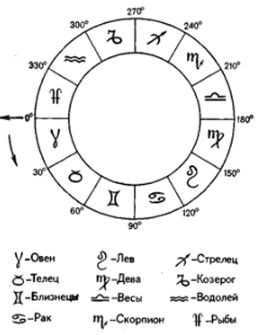
Clusters of stars known as zodiacal constellations are categorized into groups for convenience. These constellations are positioned along a circular path on the celestial sphere that corresponds to the Sun’s movement throughout the year.
The identification of zodiacal constellations dates back to ancient Greece during the Antiquity period. Nowadays, the knowledge of zodiacal constellations is utilized in the fields of astronomy and astrology.
Warning. If a teacher discovers plagiarism in your work, you may face significant consequences, potentially including expulsion. If you are unable to write the content yourself, you can place an order here.
There are a total of 13 zodiacal constellations, although astrology only acknowledges 12 of them.
Below is the order of the constellations and the corresponding dates when the Sun is within each one:

- The Sun remains in Aries from April 19 to May 13;
- The period when the Sun is in Taurus is from May 14 to June 19;
- Gemini is the constellation where the Sun is located from June 20 to July 20;
- The Sun stays in Cancer from July 21 to August 9;
- Leo is the constellation where the Sun resides from August 10 to September 15;
- The Sun’s stay in Virgo is from September 16 to October 30;
- The period when the Sun passes through Libra is from October 31 to November 22;
- Scorpio is the constellation where the Sun stays from Nov. 23 to Nov. 29;
- The Sun stays in Serpentine from November 30 through December 17;
- Sagittarius is the constellation where the Sun is located between December 18 and January 19;
- Capricorn – falls between January 20th and February 15th;
- Aquarius – occurs from February 16th to March 11th;
- Pisces – takes place from March 12th to April 18th.
The total count of constellations is approximately 88, with 12 or 13 (depending on the reference) being classified as zodiacal constellations. The movement of the zodiacal constellations is clockwise in astronomy and counterclockwise in astrology. The zodiacal circle starts at the vernal equinox point, which used to be the beginning of the Aries period. Currently, the point on the ecliptic where the ascending angle of the ecliptic and the celestial equator intersects in the northern direction is located in the Pisces constellation.
There are four primary events that determine the angular or cardinal points of the zodiac: the spring equinox, summer solstice, fall equinox, and winter solstice. Each of these events corresponds to a specific constellation: Aries (or Pisces on March 20-21), Gemini (specifically on the border of Gemini and Cancer – June 20-21), Virgo (or Libra on September 22-23), and Capricorn (December 21-22).

The boundaries of the zodiac constellations and the designation of 88 star clusters were established in 1928 during a gathering of the International Astronomical Union. It was also determined at that time where the boundaries of the actual constellations differ from the commonly accepted system of dividing the ecliptic into 12 equal parts, resulting in the Sun being within the boundaries of constellations for a period ranging from 7 to 46 days.
The Origin of the Zodiac
The history of the zodiac can be traced back to ancient Greece, specifically during the Hellenic period. It is widely believed that the classical system of the zodiacal circle was developed and popularized during this time. The Greeks built upon the existing Babylonian system and named the zodiacs after ancient heroes, creatures, and figures from various myths.
The Babylonians, however, were the ones who initially introduced the concept of dividing the zodiacal belt. The earliest references to this division can be found in the cuneiform tablets known as “Mul Apin”. The Babylonians’ hexadecimal numbering system greatly influenced the division of the zodiac into 12 parts, grouped into 4 sets of 3.
During tribal antiquity, the Pleiades and Hydra star clusters were depicted in drawings dating back 17,000 years that were discovered on the walls of the Lascaux Cave. This discovery indicates that the first instances of astrological observations occurred in ancient tribal civilizations.
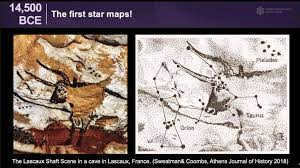
The Greek system utilized the twelve zodiacal constellations as a foundation for developing its zodiacal circle system. The initial reference to this system can be traced back to the ancient Greek mathematician, mechanic, and astronomer Eudoxus of Cnidus, who lived in the 4th century BC.
Each zodiacal constellation at that time was assigned a name, mythological background, and symbol, which only holds significance within astrology, not astronomy.
Knowledge of the zodiacal constellations eventually reached India and China around the 2nd century A.D., while the first mentions of zodiac signs in Russia appeared in 1073 in the “Izbornik Svyatoslav”.
The modern system now recognizes 13 zodiacal constellations. The addition of the Serpent constellation to the list came about due to the displacement of the Hellenistic constellation system.
How the origins of constellation names came about
The constellations acquired their names due to the ancient legend of the golden ram that came to the rescue of Phrixus and Gella, the children of the king of Boeotia. These innocent children were destined to be sacrificed as part of their stepmother’s treacherous plot, but the golden ram swooped in and carried them away to safety in Colchis. Sadly, the ram ultimately met its fate as an offering to the gods. Its stunning Golden Fleece became an iconic symbol of Colchis and also enticed the Argonauts to embark on their legendary quest in that region.

The constellation Taurus, also known as the Bull, had significant meaning in Ancient Greece. It was seen as a symbol of Zeus, the king of the gods, who abducted Europa, the beautiful daughter of Agenorus, and took her to Crete. Europa gave birth to three children, including Minos, who would later become the king of Crete. During Minos’ reign, the Minos Palace was built and the cult of the bull became prominent in Crete, giving rise to the myth of the Minotaur.
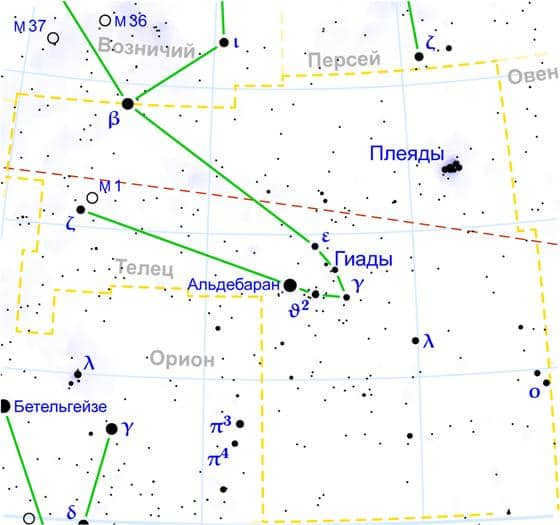

Castor and Polydeuces, also known as the Dioscuri, were twin brothers (although some versions claim they were not biologically related) who embarked on a journey to acquire the Golden Fleece alongside other Argonauts. This heroic feat brought them everlasting fame and remembrance. Renowned for their exceptional combat skills and survival knowledge, their expertise greatly contributed to the successful voyage of the Argonauts to Colchis. In order to achieve immortality, they ascended to the heavens.
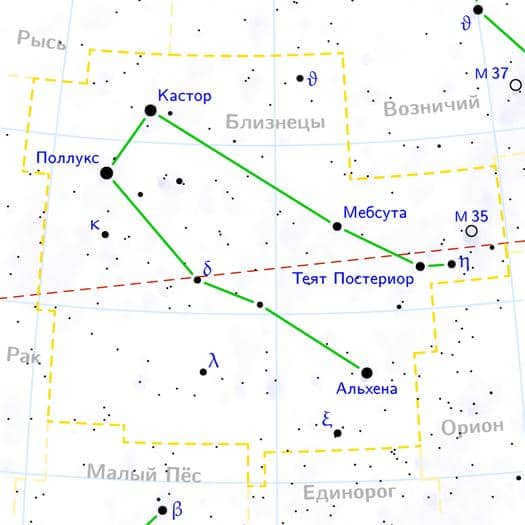
Legend has it that during Heracles’ battle with the Lernaean Hydra, Hera dispatched a crayfish to annoy and divert the hero. In response, Heracles propelled the crayfish into the heavens, among the stars, with a swift kick of his foot.
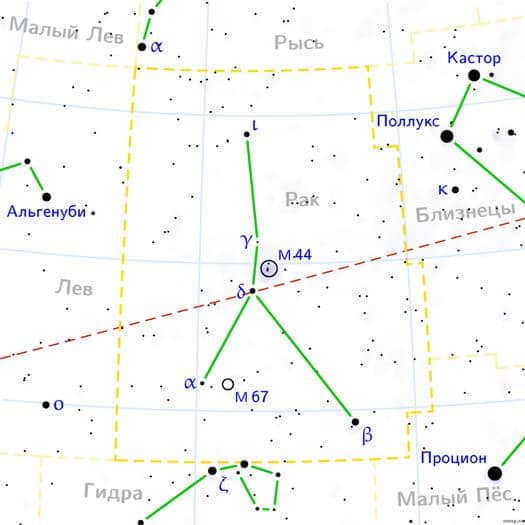
The Nemean lion used to dwell in a cavern close to Corinth and posed a great threat to humans, as it was an avid hunter of them. In his initial act of valor, Heracles managed to strangle the lion that no other heroes had been able to vanquish with any weapon. Heracles then proudly adorned himself with the lion’s skin, wearing it as a mantle. As a tribute to his remarkable feat, the gods elevated the lion to the heavens, recognizing him as the ruler of all creatures.
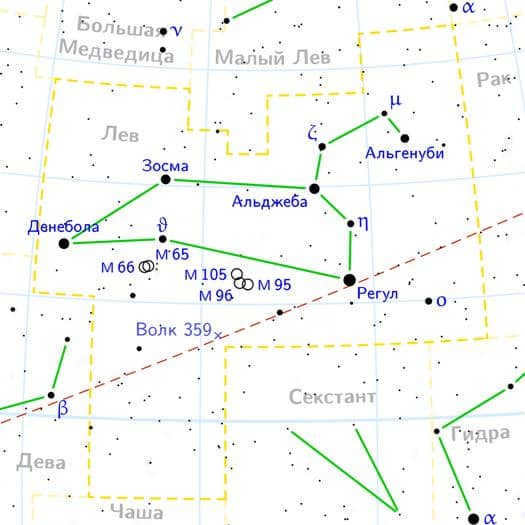
Dica, the goddess of justice and daughter of Zeus and Themis, supposedly lived during mankind’s Golden Age. She opposed the introduction of innovations on Earth, specifically those associated with the murder of Cronus. Dica attempted to restore people’s faith in the gods but was ultimately disappointed. As a result, she departed the Earth and never returned.
In addition, Virgo is associated with Demeter, the Syrian goddess of fertility Atargatis, and Erigon.
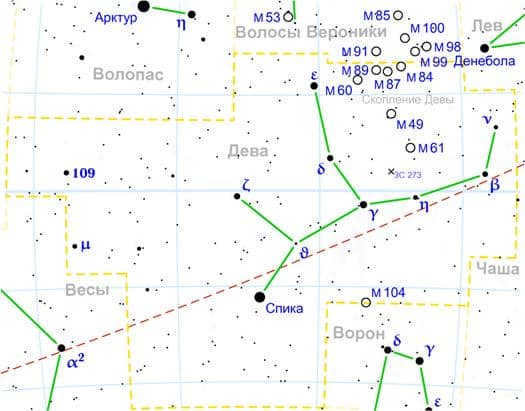
In ancient Greece, Scorpio was seen as an extension of this constellation. It was during the Roman period that the association with scales emerged. This is because Rome was established at a time when the Moon transitioned into Libra. The Romans held this zodiac sign in high esteem.
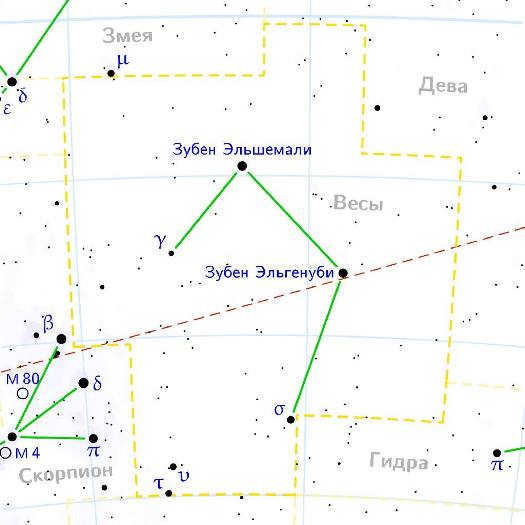
Orion, the hunter, met his demise at the hands of Scorpio. There are two differing accounts as to why this tragic event occurred. One version suggests that Artemis, the goddess of hunting, sent the scorpion to punish Orion for his aggressive pursuit of her love. Another version claims that Gaia, the Earth goddess, dispatched the scorpion in order to exact revenge on the boastful hunter, who arrogantly boasted of his ability to vanquish any creature.

The legend of the serpent is linked to the tale of Asclepius, the offspring of Apollo, who possessed the power to bring the deceased back to life. This talent was not bestowed upon him by the deities, but rather acquired through his own efforts. Asclepius met his demise by the wrath of Zeus’ lightning bolt, after Zeus and Hades conspired to eliminate the hero in order to prevent mortals from attaining immortality.
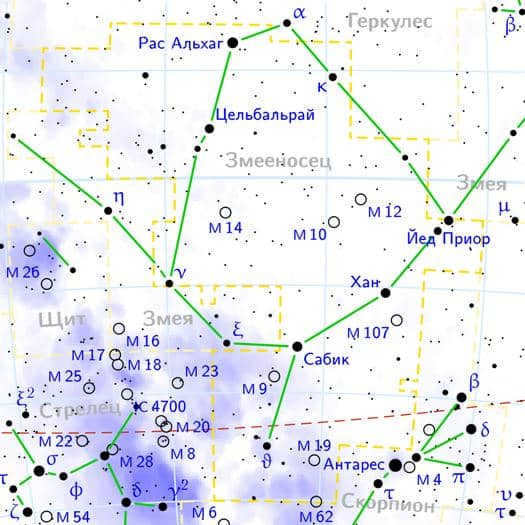
After the death of the mythical satyr Krotus, Zeus’s daughters, the 9 Muses, showed their gratitude by asking their father to elevate their protector to the heavens as a way to honor his memory. Krotus, who was the son of Pan, is credited with inventing archery as a hunting technique and was revered as its patron saint.
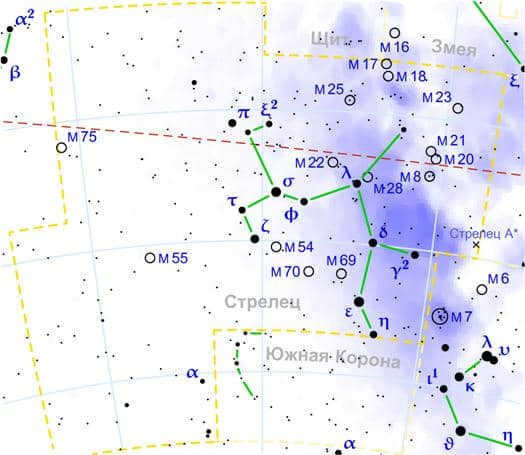
In Greek mythology, Capricorn was associated with the forest deity, Pan. Pan was known for his bravery, as he saved the gods multiple times and played a crucial role in the war against the Titans by terrifying them. Additionally, Pan had the ability to transform into different animals, but one day his transformation was interrupted and he was left half-transformed. Zeus, the king of the gods, decided to honor Pan by placing him in the heavens in this unique form.

Aquarius, the son of Tros, was known by his given name Ganymede. He possessed remarkable beauty, which caught the attention of Zeus. Fascinated by his appearance, Zeus devised a plan to abduct Ganymede and bring him to Mount Olympus. There, Ganymede would serve the gods and be responsible for pouring nectar from an amphora into their gleaming glasses.
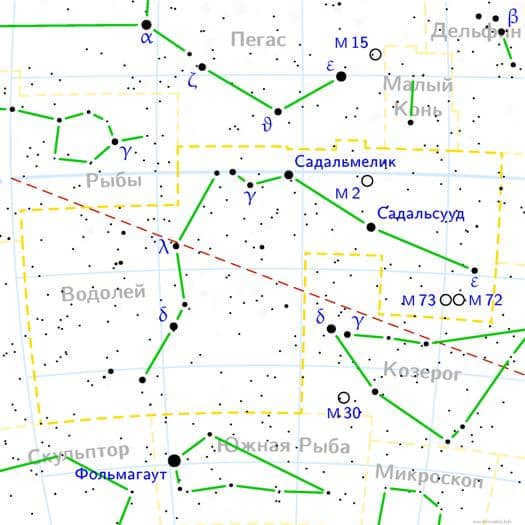
The legend tells the tale of Aphrodite and her son Eros, who were transformed into fish to evade danger during the epic battle between the gods of Olympus and the powerful Titans and Gaia. With the aid of river nymphs and fish, they were able to successfully escape the wrath of the deities by taking on the form of aquatic creatures.
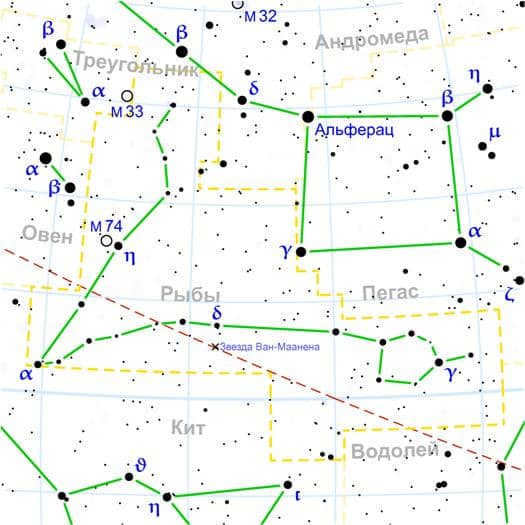
Zodiac Signs and the Position of the Sun
There are 13 constellations in the zodiac, but astrology only recognizes 12 of them. Russian astrologers usually go with the second option:
- Aries – the Sun stays in this sign from March 21 to April 19 (or March 21 to April 20);
- Taurus – from April 20 to May 20 (or April 21 to May 21);
- Gemini – from May 21 to June 20 (or May 22 to June 21);
- Cancer – from June 21 to July 22 (or June 22 to July 22);
- Leo – from July 23 to August 22 (or July 23 to August 21);
- Virgo – from August 23 to September 22 (or August 22 to September 23);
- Libra – from September 23 to October 22 (or September 24 to October 23);
- Scorpio – from October 23 to November 21 (or October 24 to November 22);
- Sagittarius – November 22 through December 20 (or November 23 through December 22);
- Capricorn – from December 21 to January 19 (or December 23 to January 20);
- Aquarius – January 20 through February 18 (or January 21 through February 19);
- Pisces – February 19 to March 20 (or February 20 to March 20);
- Serpentine.
Astrology utilizes this information to calculate the zodiac sign under which an individual was born at the time of its appearance in the sky. It is believed that different signs have varying effects on people. Individuals belonging to a particular sign may possess unique character traits: for instance, Virgo is associated with cleanliness, while Aries is associated with hyperactivity. Information about the signs can differ from source to source, and is also expanded through the creation of birth charts.
It is important to note that astrology is not officially recognized as a science, as it lacks proven scientific methods of operation.
Key Takeaways
In the lesson on zodiac constellations, we have learned:
- The ecliptic is the path of the sun’s motion, and it is along this path that the zodiac constellations are situated;
- The name “zodiac constellations” comes from the ancient Greek word for “living creatures” or “animals,” as they make up the majority of constellation names;
- The first mention of constellations dates back 17,000 years;
- Two fields of study examine constellations, astronomy, and astrology, but only the former is considered a science;
- In astronomy, the motion is clockwise relative to the zodiac constellations, while in astrology, it is counterclockwise;
- The definitions of “zodiac sign” and “constellation” are distinct.
- Out of the 88 constellations, only 13 are zodiacal.
- All constellation names are derived from the myths of ancient Greece or Rome.
- The position of the Sun in the zodiac signs differs from its actual position in the constellations.
Did you find the article helpful?

Distinctive formations in the celestial sphere are known as constellations. Individuals have always gazed at the stars, pondering the enigma of their cosmic origins. They seek to identify the constellations they have read or heard about among the vast expanse of stars. Among these celestial arrangements, twelve of them represent the zodiac symbols. Each constellation is accompanied by legends that recount its discovery and provide an explanation for its name. What exactly are the zodiac signs?
Arrival of Zodiac Symbols in the Celestial Sky
The celestial sphere encompasses a specific band known as the zodiac, through which the Sun, the Moon, and several planets traverse, intersecting twelve constellations. These celestial formations, situated within the zodiacal realm, acquired their appellation – zodiacal constellations. In ancient astrology, each of these constellations was assigned a unique symbol, referred to as a zodiac symbol. Allow me to recount the intriguing tale of the inception of these zodiac symbols.
What is the total number of them

The sun completes a full orbit around the celestial sphere in one year. The circular path that it follows, known as the zodiac, spans a total of 360 degrees and is divided into 12 sectors, each measuring 30 degrees. These sectors are named after the constellations that the Sun passes through during its journey.
Each month is associated with a specific zodiac symbol, which represents the path of the Sun during that time. In ancient times, people used the constellations of the zodiac as a calendar, as the Sun would travel through each one for about a month. However, due to the movement of the Vernal Equinox point (which shifts by 1° every 70 years), the Sun now moves through two neighboring constellations in one month. Despite this change, the traditional designations for the months have been preserved. The Sun spends the longest time in the constellation of Virgo, approximately 44 days, while it only passes through Scorpio for 6 days. It is worth noting that between November 30 and December 18, the Sun also passes through a cluster of stars known as the Serpentine. However, historically, this period was not included as a separate month in the zodiac symbols.
Etymology of names
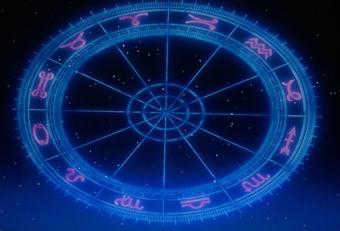
Each zodiac constellation has its own unique name. According to one theory, the names of the zodiac symbols are derived from the adventures of Hercules. Other theories are based on ancient Greek myths about the gods of Olympus. Each name and symbol has its own legend. Interestingly, despite their ancient Greek origins, all the names of the zodiac symbols have always been written in Latin.
Currently, astronomers classify the 12 zodiac symbols into 4 elements:
- Earth – Capricorn, Taurus, Virgo;
- Water – Cancer, Scorpio, Pisces;
- Fire – Aries, Leo, Sagittarius;
- Air – Libra, Aquarius, Gemini.
As per the mystical teachings, each zodiac sign represents a constellation in the sky and influences the personality traits of individuals born under them (i.e., in the month when the Sun passes through a specific constellation).
Aries Constellation
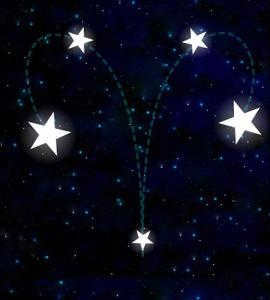
The zodiac sign Aries corresponds to the first months of spring, namely March and April (21.03 – 20.04). Aries is made up of a constellation consisting of 20 stars, with Mezartim, Sharatan, and Gamal being the three brightest stars. It is interesting to note that around 2000 years ago, the point of the spring equinox was located in Aries. Astrologers believe that it will take another 24,000 years for the spring equinox to return to this position.
There is a myth associated with Aries, in which it saves two children named Frix and Gella from their evil stepmother Ino, who planned to sacrifice them. Although the fate of the children turned out differently, the memory of the golden-horned lamb, which represents Aries, is forever preserved in the night sky.
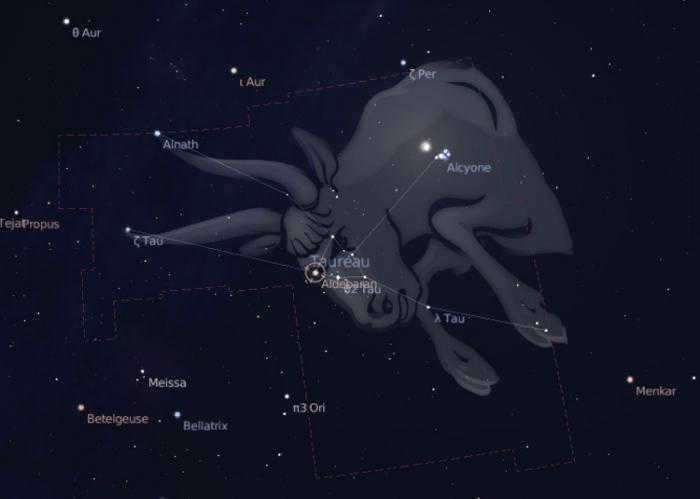
Taurus (April 21 – May 21) is an extremely noticeable constellation. A keen observer can spot as many as 130 stars in it, with 14 being particularly easy to see. The most brilliant ones include Aldebaran, Nat, Alcyon, and Zeta of Taurus. The summer solstice point is also located in this constellation.
According to a certain myth, Taurus is associated with Zeus who assumed this form to abduct Europa, the daughter of the Phoenician king.
Gemini
Gemini is the third astrological sign in the zodiac, originating from the constellation of Gemini. It is represented by the twins Castor and Pollux.
People born under the Gemini sign are known for their dual nature. They are often described as being intellectual, curious, and adaptable. Geminis are also known for their excellent communication skills and ability to express themselves effectively.
However, Geminis can also be indecisive and prone to inconsistency. They may struggle with making decisions and sticking to them, often changing their minds multiple times.
Overall, Gemini is a versatile and dynamic sign, representing the duality of human nature. Geminis are constantly seeking new experiences and knowledge, making them excellent communicators and lifelong learners.
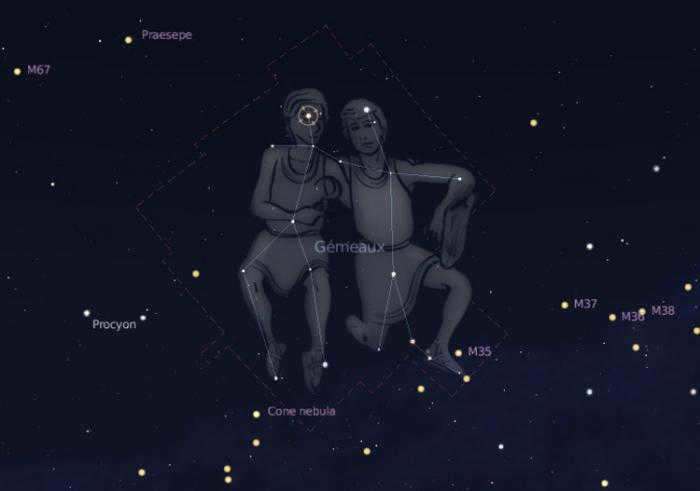
About 70 stars can be observed in the constellation of Gemini, with Castor and Pollux being the brightest among them. The remarkable bond of brotherly love between Castor and Pollux, as depicted in Greek mythology, inspired people to identify and name these two shining celestial stars as Gemini. This constellation corresponds to the period between May and June (22.05 – 21.06).
The constellation of Cancer
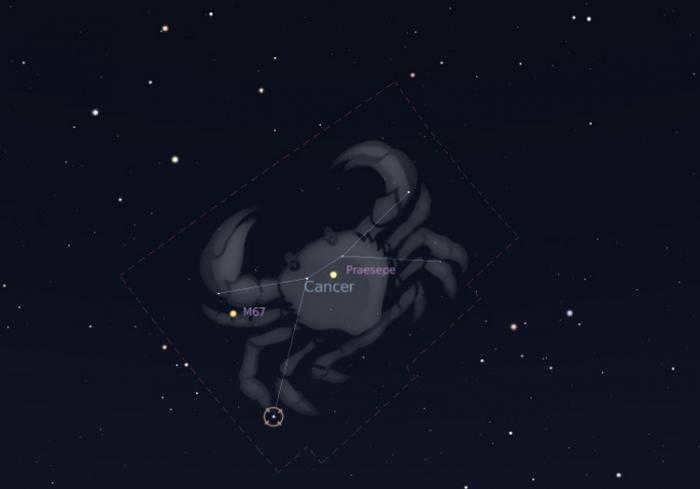
The zodiac sign Cancer corresponds to the summer months of June and July (22.06 – 23.07). The Cancer constellation is both massive and subtle, often overshadowed by its brighter neighbors Leo and Gemini. On clear nights, it is possible to observe around 60 stars of this constellation without the aid of telescopic instruments. The brightest star in Cancer is Altarf, also known as Beta Cancer.
Legend has it that the appearance of this constellation in the sky is linked to the fierce rival of Heracles, Hera. It is said that she placed a sea monster in the sky, which had bitten Heracles during his battle with Hydra. Although the legend refers to a crab, astrologers prefer the name Cancer.
The Leo constellation

Leo, a zodiac symbol, is derived from the constellation of the same name, which is most prominent in the months of July and August. This particular constellation is known for its brightness, with its largest star being called Regulus, meaning “king.” Additionally, the constellation has an intriguing feature: every 33 years in November, it is possible to witness meteor showers known as star showers.
The myth surrounding the appearance of the Leo constellation is linked to the Nemean lion, a creature defeated by the half-woman half-snake Echidna. This lion was ultimately conquered by Heracles, the illegitimate son of Zeus. To immortalize this victory, the mighty thunderer took the defeated monster to the heavens.
The zodiac sign Virgo
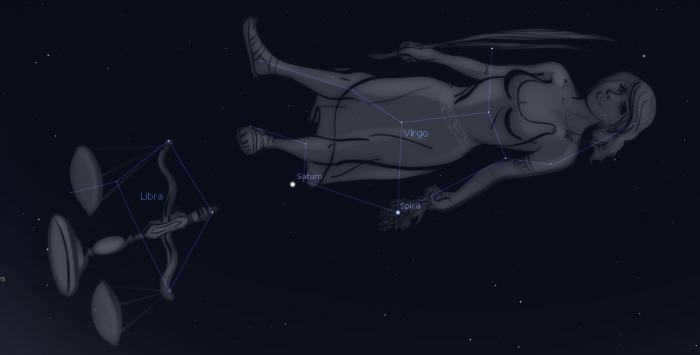
Virgo is a vast collection of stars located within the zodiac. Without the need for a telescope, 164 stars in this constellation are visible to the naked eye. The most luminous star among them is Spica. In our current era, Virgo marks the point of the autumnal equinox. This zodiac sign corresponds to the months of August and September.
There exist numerous legends that associate Virgo with various mythical figures such as Rhea, the mother of Zeus, Themis, and Gaea, the mother earth.
The months of September and October are known as Libra. In the past, the stars that make up this constellation were part of Scorpio, but they eventually separated and formed a new constellation. The origin of Libra is linked to Astrea, the daughter of Zeus, who tirelessly walked the earth, using scales to assess the fairness of people’s actions.
This constellation is composed of 83 stars, with the brightest ones being Zuben el Shemali and Zuben el Genubi.
Scorpio
The Scorpion is the eighth sign of the zodiac and is represented by the symbol ♏. Scorpios are known for their intense and passionate nature. They are often seen as mysterious and enigmatic individuals. Scorpios are known for their deep emotions and their ability to feel things deeply. They are also known for their determination and their strong willpower. Scorpios are natural leaders and are often seen as powerful and influential. They are also known for their loyalty and their ability to protect those they care about. Overall, Scorpios are complex and multifaceted individuals who have a lot to offer in terms of their depth and intensity.
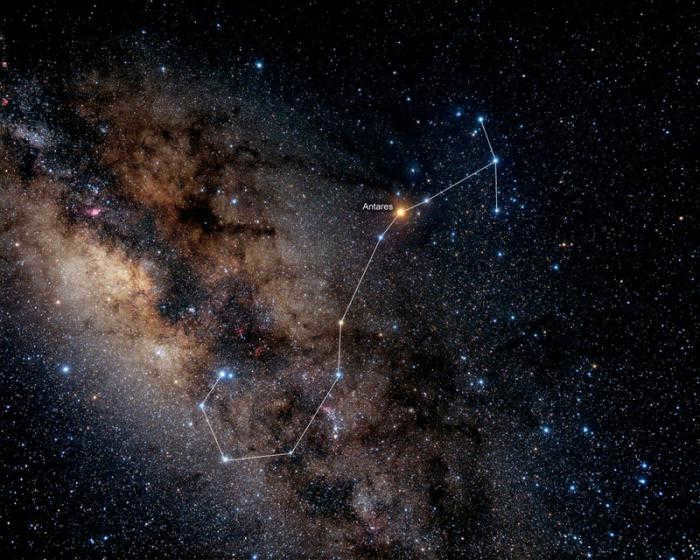
Scorpio has claimed its position among the zodiac symbols. This constellation, located in the southern sky, is one of the most prominent ones with a total of 17 stars, with Antares shining the brightest.
According to myths, Scorpio fatally stung the young hunter Orion, and since then, it has been permanently residing next to him in the celestial heavens. This zodiac symbol is associated with the months of October and November.
Sagittarius
Sagittarius is a zodiac sign that falls between November 22 and December 21. It is represented by the symbol of the archer, which reflects the adventurous and independent nature of those born under this sign.
Sagittarians are known for their love of freedom and their desire to explore new horizons. They are natural-born travelers and are always on the lookout for new experiences and opportunities. They have a strong sense of curiosity and are constantly seeking knowledge and understanding.
Sagittarians are also known for their optimism and positivity. They have a natural ability to see the bright side of any situation and are always able to find a silver lining. They have a great sense of humor and are often the life of the party.
However, Sagittarians can also be impatient and restless. They have a tendency to get bored easily and are always looking for the next big thing. They can also be blunt and honest to a fault, sometimes coming across as tactless or insensitive.
In relationships, Sagittarians are loyal and committed. They value their independence and need a partner who can understand and support their need for freedom. They are honest and straightforward in their communication and expect the same in return.
Overall, Sagittarians are adventurous, optimistic, and independent individuals. They have a zest for life and are always looking for new experiences and opportunities. They bring a sense of excitement and enthusiasm to everything they do.
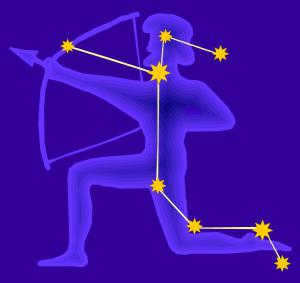
The Sagittarius constellation, which can be seen during the months of November and December, is a dazzling group of stars. When observing closely, one can spot 115 stars within the constellation, including 14 particularly bright ones such as Alnazl, Albaldach, Kaus Borealis, Kaus Meridianalis, Askella, Nunki, and Kaus Australis.
This section of the sky is incredibly captivating, housing three nebulae, the center of the galaxy, and even a supermassive black hole. Sagittarius is also significant as it marks the point of the winter solstice.
The constellation Sagittarius takes the form of a powerful mythological centaur, forever galloping across the celestial sphere.
Capricorn
can be paraphrased as
The sign of the Goat
.
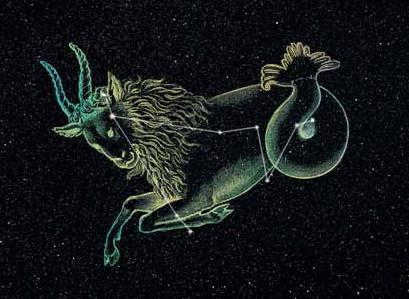
The zodiac sign associated with the months of December and January is Capricorn. It is possible to see 86 stars in this constellation without the use of telescopic equipment. Out of all the stars in Capricorn, the brightest one is known as beta.
There are numerous legends surrounding this constellation. According to Greek mythology, Capricorn is the son of Hermes. Fleeing from the hundred-headed Titan, he plunged into the sea. As a result, his appearance drastically changed and he transformed into a goat with a fish tail. The gods were astonished by the monster’s new form and decided to bring him to the heavens.
Aquarius
can be rephrased as
The Water Bearer
.
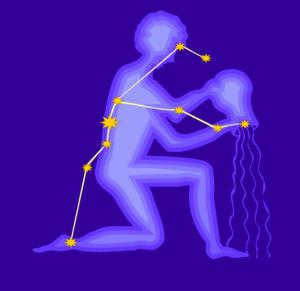
Aquarius, which falls between the months of January and February, is a significant group of stars that can be seen along the solar path. It consists of seven bright stars and is most easily observed from August to October. During the latter part of summer, there are active meteor showers that can be witnessed within the Aquarius constellation. One notable feature of Aquarius is the presence of the Snail nebula, which is the largest and closest nebula to Earth. The name of the constellation, according to ancient legends, translates to “master of waters.”
